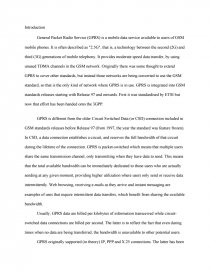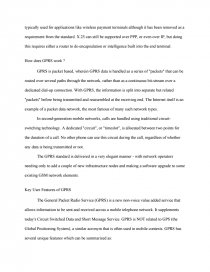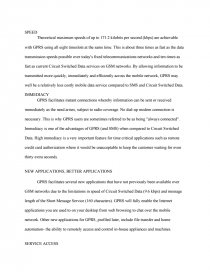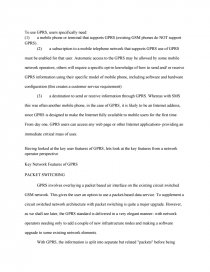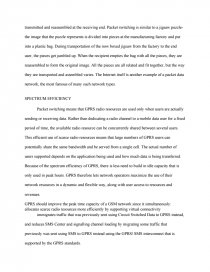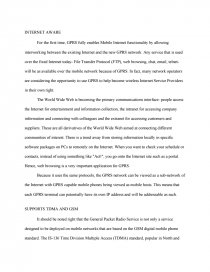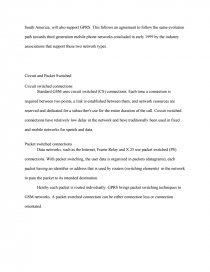Gprs Technology in Gsm
Essay by review • February 21, 2011 • Research Paper • 1,891 Words (8 Pages) • 1,432 Views
Introduction
General Packet Radio Service (GPRS) is a mobile data service available to users of GSM mobile phones. It is often described as "2.5G", that is, a technology between the second (2G) and third (3G) generations of mobile telephony. It provides moderate speed data transfer, by using unused TDMA channels in the GSM network. Originally there was some thought to extend GPRS to cover other standards, but instead those networks are being converted to use the GSM standard, so that is the only kind of network where GPRS is in use. GPRS is integrated into GSM standards releases starting with Release 97 and onwards. First it was standardised by ETSI but now that effort has been handed onto the 3GPP.
GPRS is different from the older Circuit Switched Data (or CSD) connection included in GSM standards releases before Release 97 (from 1997, the year the standard was feature frozen). In CSD, a data connection establishes a circuit, and reserves the full bandwidth of that circuit during the lifetime of the connection. GPRS is packet-switched which means that multiple users share the same transmission channel, only transmitting when they have data to send. This means that the total available bandwidth can be immediately dedicated to those users who are actually sending at any given moment, providing higher utilization where users only send or receive data intermittently. Web browsing, receiving e-mails as they arrive and instant messaging are examples of uses that require intermittent data transfers, which benefit from sharing the available bandwidth.
Usually, GPRS data are billed per kilobytes of information transceived while circuit-switched data connections are billed per second. The latter is to reflect the fact that even during times when no data are being transferred, the bandwidth is unavailable to other potential users.
GPRS originally supported (in theory) IP, PPP and X.25 connections. The latter has been typically used for applications like wireless payment terminals although it has been removed as a requirement from the standard. X.25 can still be supported over PPP, or even over IP, but doing this requires either a router to do encapsulation or intelligence built into the end terminal.
How does GPRS work ?
GPRS is packet based, wherein GPRS data is handled as a series of "packets" that can be routed over several paths through the network, rather than as a continuous bit-stream over a dedicated dial-up connection. With GPRS, the information is split into separate but related "packets" before being transmitted and reassembled at the receiving end. The Internet itself is an example of a packet data network, the most famous of many such network types.
In second-generation mobile networks, calls are handled using traditional circuit-switching technology. A dedicated "circuit", or "timeslot", is allocated between two points for the duration of a call. No other phone can use this circuit during the call, regardless of whether any data is being transmitted or not.
The GPRS standard is delivered in a very elegant manner - with network operators needing only to add a couple of new infrastructure nodes and making a software upgrade to some existing GSM network elements.
Key User Features of GPRS
The General Packet Radio Service (GPRS) is a new non-voice value added service that allows information to be sent and received across a mobile telephone network. It supplements today's Circuit Switched Data and Short Message Service. GPRS is NOT related to GPS (the Global Positioning System), a similar acronym that is often used in mobile contexts. GPRS has several unique features which can be summarized as:
SPEED
Theoretical maximum speeds of up to 171.2 kilobits per second (kbps) are achievable with GPRS using all eight timeslots at the same time. This is about three times as fast as the data transmission speeds possible over today's fixed telecommunications networks and ten times as fast as current Circuit Switched Data services on GSM networks. By allowing information to be transmitted more quickly, immediately and efficiently across the mobile network, GPRS may well be a relatively less costly mobile data service compared to SMS and Circuit Switched Data.
IMMEDIACY
GPRS facilitates instant connections whereby information can be sent or received immediately as the need arises, subject to radio coverage. No dial-up modem connection is necessary. This is why GPRS users are sometimes referred to be as being "always connected". Immediacy is one of the advantages of GPRS (and SMS) when compared to Circuit Switched Data. High immediacy is a very important feature for time critical applications such as remote credit card authorization where it would be unacceptable to keep the customer waiting for even thirty extra seconds.
NEW APPLICATIONS, BETTER APPLICATIONS
GPRS facilitates several new applications that have not previously been available over GSM networks due to the limitations in speed of Circuit Switched Data (9.6 kbps) and message length of the Short Message Service (160 characters). GPRS will fully enable the Internet applications you are used to on your desktop from web browsing to chat over the mobile network. Other new applications for GPRS, profiled later, include file transfer and home automation- the ability to remotely access and control in-house appliances and machines.
SERVICE ACCESS
To use GPRS, users specifically need:
(1) a mobile phone or terminal that supports GPRS (existing GSM phones do NOT support GPRS) .
(2) a subscription to a mobile telephone network that supports GPRS use of GPRS must be enabled for that user. Automatic access to the GPRS may be allowed by some mobile network operators, others will require a specific opt-in knowledge of how to send and/ or receive GPRS information using their specific model of mobile phone, including software and hardware configuration (this creates a customer service requirement)
(3) a destination to send or receive information through GPRS. Whereas with SMS this was often another mobile phone, in the case of GPRS, it is likely to be an Internet address, since GPRS is designed to make the Internet fully available to mobile users for the first time. From day one, GPRS users can access any web page or other Internet applications- providing an immediate critical mass of uses.
Having
...
...
